I’ve said it many times already, but living in Bangladesh is like going back in time. Blacksmiths have all but disappeared in America, though artisan smiths are making something of a comeback. Every little town in Bangladesh has a blacksmith. The smiths in this picture are making a multipurpose “kodal” which is sort of a cross between a shovel and a hoe. The air bellows—partially blocked by one of the blacksmith’s head—is made out of an old truck inner tube.

I’ve also repeated that nothing is wasted in Bangladesh. Tin cans of all sizes are cut up, shaped and soldered into useful articles. In this picture, the tinsmith has made a funnel. His other hand is operating a fan that forces air into charcoal to heat up the soldering iron.
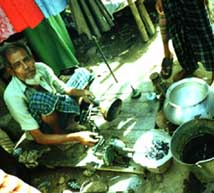 The tinsmith was in the market place in Feni, a fairly big town in southern Bangladesh where my wife and I spent three months learning the Bengali language. I was encouraged to spend time at the market place to practice the language. One day I took some old, dull scissors along with me because I was told there was a professional sharpener somewhere there. I asked around and finally found him.
The tinsmith was in the market place in Feni, a fairly big town in southern Bangladesh where my wife and I spent three months learning the Bengali language. I was encouraged to spend time at the market place to practice the language. One day I took some old, dull scissors along with me because I was told there was a professional sharpener somewhere there. I asked around and finally found him.
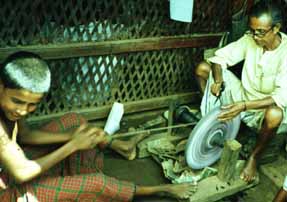 As soon as I saw him I knew I had made a mistake. As you can see, the setup was very crude. The man’s son would pull a rope to make the grindstone go around. Oh well, it was a lousy pair of scissors anyhow. He used the grindstone, then it turned out he had some other tools in the wooden box he was sitting on.
As soon as I saw him I knew I had made a mistake. As you can see, the setup was very crude. The man’s son would pull a rope to make the grindstone go around. Oh well, it was a lousy pair of scissors anyhow. He used the grindstone, then it turned out he had some other tools in the wooden box he was sitting on.
After he’d worked on the scissors for awhile, I thought he said to give him my hand, but I wasn’t sure. Seeing my hesitation, he reached for my hand and turned it so the back faced up. My heart skipped a beat as he extended the scissors toward me. In a single, quick stroke he used the scissors to shave a patch of my hairy arm so it was as bare as a baby’s behind. Next day I took him all the knives from the kitchen I could find. I have never seen sharper knives, and try as I might I have not been able to find scissors that I could shave the back of my arm with. I gotta go back to Bangladesh someday and get those scissors.
The tinsmith and the sharpener occupied a few square feet at the marketplace. Like the sandal makers, locksmiths, guys who recharge “disposable” lighters and a lot of other people, their shop is wherever they plunk down their tools. Then they take the tools home with them at the end of the day. The extreme form of that portability might be this skilled bus transmission mechanic who just sets up on the side of the road and somehow gets the job done.
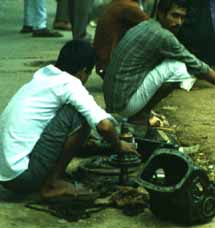
The importance of bricks extends beyond making walls. Wherever there is a major construction project you will see workers breaking bricks into chips. That’s because there is nothing else to make gravel needed for concrete mixes from. No rocks, stones boulders or pebbles. Sometimes rocks are imported from the hill areas, but it costs money to transport them. So as often as not, it’s cheaper to break imperfect bricks.
 The people who do the brick breaking are the poorest of the poor. Although this family is working in the most prosperous area of Bangladesh, they still have a difficult life. The umbrellas are to shade them from the hot sun. Consider this “working mother” who has a sleeping baby in one hand and a hammer in the other. Bangladesh is one of the poorest countries in the world. These are some of the poorest people in Bangladesh.
The people who do the brick breaking are the poorest of the poor. Although this family is working in the most prosperous area of Bangladesh, they still have a difficult life. The umbrellas are to shade them from the hot sun. Consider this “working mother” who has a sleeping baby in one hand and a hammer in the other. Bangladesh is one of the poorest countries in the world. These are some of the poorest people in Bangladesh.
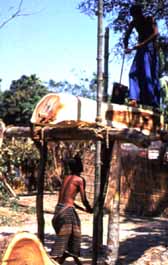
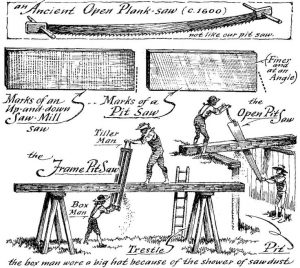
Eric Sloan authored and illustrated a fun book about early American technology titled Diary of an Early American Boy. In it he showed how pit saws were used to saw out boards by hand before sawmills took over. Pit saws are still used in Bangladesh in remote regions.
Before I went to Bangladesh I kind of figured snake charming was something dreamed up by South Asian tourist bureaus. Not so! It’s traditional form of entertainment for ordinary people.
 The best of the snake charmers put on a wild show. My brain was pretty sure the handlers took the venom out of the cobra snakes somehow. But my autonomic nervous system sent lots of adrenaline coursing through my veins in preparation for the fight or flight—more likely the later. Did you notice that these kids are quite interested, but they are not exactly pushing to get to the front of the crowd for a closer look?
The best of the snake charmers put on a wild show. My brain was pretty sure the handlers took the venom out of the cobra snakes somehow. But my autonomic nervous system sent lots of adrenaline coursing through my veins in preparation for the fight or flight—more likely the later. Did you notice that these kids are quite interested, but they are not exactly pushing to get to the front of the crowd for a closer look?
